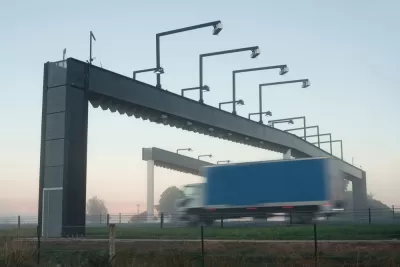"The road usage charge is the logical evolution in the way we fund surface transportation," stated Patrick Jones, Executive Director of the International Bridge, Tunnel and Turnpike Association at their annual transportation conference in Portland.

Oregon was the first state to charge a gas tax in 1919: a one cent per-gallon tax. The federal government followed in 1932, also with a one cent tax. In just over two months, the Beaver State will again make history in North America by implementing the first road usage charge (RUC) as a replacement for the state gas tax for 5,000 volunteer participants.
As with Jones, the overriding sentiment at IBTTA's Transportation Finance & Road Usage Charging Conference is that the gas tax is not sustainable as a road funding mechanism, and that the future is in the road usage charge [also called the vehicle-miles-traveled (VMT) fee and the mileage-based user fee (MBUF).].
At a press event held concurrently with the IBTTA conference on Monday, the Oregon Department of Transportation (ODOT) announced that three private business partners are now technically certified to manage accounts and collect road user fees from those accounts for deposit into the State Highway Fund. Representatives from the three companies were on hand to show and explain their plug-in devices:

- Azuga [Credit for above image: Azuga G2™]
- Sanef/Intelligent Mechatronic Systems (Sanef ITS/IMS): the only one supplying a non-GPS device at this time
- Verizon Telematics
"This is the wave of the future,” said Jim Whitty, manager of the OReGO program. “We’ve got to find a more sustainable and fair way to fund highway maintenance and new construction or our economy will suffer as our roads get more crowded and less safe.”
Nate Bryer of Azuga explained that the RUC will essentially work as a public-private-partnership: Participants select one of the three providers, install their device into their vehicle's on-board diagnostics (OBD) system, and receive a quarterly bill, or rebate check from that company, though Sanef ITS/IMS may be listed under ODOT.The device will not only determine how much you drove, but how much fuel you used—necessary to subtract the appropriate gas tax as the RUC is meant to replace the gas tax, not supplement it.
The 1.5 cents RUC is approximately equivalent to 20 mpg, therefore vehicles with low mpg may expect to see rebate checks. Consequently, according to the FAQ, OReGO restricts participation in the 5,000 vehicle program to:
- No more than 1,500 vehicles rated at less than 17 mpg.
- No more than 1,500 vehicles rated from 17 to less than 22 mpg.
Almost all presenters at the IBTTA conference believed that the RUC was inevitable due to the multiple deficiencies of gas taxes, most importantly:
- Increased fuel efficiency of vehicles,
- Inflation, particularly in highway maintenance and construction,
- Increased alternative-fuel vehicles, e.g. electric vehicles, that pay no gas tax.
Speakers also mentioned that the reduction in driving, i.e., vehicle-miles-traveled, also would reduce gas tax revenue, though that will reduce RUC revenues as well.
However, during a panel discussion, Jim Whitty was asked if the RUC charge would be indexed for inflation, and if not, why would it not differ from a non-indexed gas tax resulting in declining gas tax revenues?
Whitty responded that the 1.5 cents rate would not be indexed - only the legislature can make that call. The purpose of the new program that begins July 1—which is not a pilot, was to see how well the road usage charge works. Bryer called the program that begins in two months a "soft launch."
Interestingly, I did find one outlier in the "blessing of the RUC"—a speaker from Moody's Investor Service. Maria Matesanz, Senior VP, Global Project Finance and Infrastructure Group, made it clear that her firm must look at revenue, so she was reluctant to join with others in predicting the inevitability of RUC.
I noted that Moody's recently praised Iowa for their 10 cents per-gallon tax increase that took effect on March 1. "Moody's called the action by state officials a 'credit positive' because it avoids one-time fixes to raise the money needed for Iowa's 114,000 miles of roads and 25,000 bridges," wrote William Petroski of The Des Moines Register.
In fact, Matesanz surprisingly indicated that the reduced oil prices and improved economy had resulted in increased driving and thus increased gas tax revenue.
Matesanz then added that the RUC "is a very interesting, dynamic, forward thinking solution."
FULL STORY: Is the Road Usage Charge the Future of Road Funding?

Trump Administration Could Effectively End Housing Voucher Program
Federal officials are eyeing major cuts to the Section 8 program that helps millions of low-income households pay rent.

Planetizen Federal Action Tracker
A weekly monitor of how Trump’s orders and actions are impacting planners and planning in America.

Ken Jennings Launches Transit Web Series
The Jeopardy champ wants you to ride public transit.

Washington Legislature Passes Rent Increase Cap
A bill that caps rent increases at 7 percent plus inflation is headed to the governor’s desk.

From Planning to Action: How LA County Is Rethinking Climate Resilience
Chief Sustainability Officer Rita Kampalath outlines the County’s shift from planning to implementation in its climate resilience efforts, emphasizing cross-departmental coordination, updated recovery strategies, and the need for flexible funding.

New Mexico Aging Department Commits to Helping Seniors Age ‘In Place’ and ‘Autonomously’ in New Draft Plan
As New Mexico’s population of seniors continues to grow, the state’s aging department is proposing expanded initiatives to help seniors maintain their autonomy while also supporting family caregivers.
Urban Design for Planners 1: Software Tools
This six-course series explores essential urban design concepts using open source software and equips planners with the tools they need to participate fully in the urban design process.
Planning for Universal Design
Learn the tools for implementing Universal Design in planning regulations.
Heyer Gruel & Associates PA
Ada County Highway District
Institute for Housing and Urban Development Studies (IHS)
City of Grandview
Harvard GSD Executive Education
Toledo-Lucas County Plan Commissions
Salt Lake City
NYU Wagner Graduate School of Public Service


























